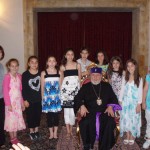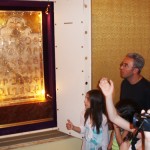Today we went to Echmiadzin and Oshagan.
Echmiadzin was built in the 4th century, from 301-303. It was the first Armenian church. Krikor Lousavoritch had a vision of Jesus coming down from the sky, and with a golden hammer, showing where the first Armenian church would be built. He included all the details of the church, as well. “Echmiadzin” means “the place where God’s only son came down”.
In front of the Mother Cathedral, is situated the residence of the Armenian Catholicos, Garegin II. Next to the building of the residence, there is a museum called “Treasury”, where you can see very valuable rugs, carpets, garments, the Catholicos’ jewels, and attires belonging to the Catholicos. But the gems of the museum are two items…The first one is the Armenian alphabet in gold and diamonds. The second one is the magnificent cross stone (khatchkar) made of gold, diamonds, and other precious stones.
In the yard, some beautiful cross stones are scattered, which have been brought from different parts of historical Armenia. On the wall of the Mother Cathedral, there is the etched image of the Persian Shah Apas II. He wanted to destroy the church of Echmiadzin, but the Armenians learned about it in advance, and they carved the image of the invader on the wall so as to please him. When Shah Apas II saw this, he didn’t destroy the church of Echmiadzin.
Inside the Mother Cathedral, there is a museum where the “Holy Lense” is kept. One of the Roman legionaries wanted to check if Jesus was alive or not and he wounded his side by a spear which later was brought to Armenia by the apostle Thaddeus.
The Cathedral of Echmiadzin was very big and elegant. It had a lot of very detailed designs on the walls, which had some Arabic colors in it, since its walls were painted during the time of the Arab rule over Armenia. The designs were beautiful, and it was the first church we had seen to have so many intricate designs. The choir was excellent.
The Mother Cathedral was very unique because of its many “sections”, which we didn’t see in any other church. They renovate it regularly, but the Alter is the oldest part of the church. They also do church service, which means that even though the church is old, it is still in use.
Oshagan was very pretty: it was named after its fertile fields. When Noy Nahabed came down from Mt. Ararat, he saw fertile fields, full of plants and trees, and therefore named it “Oshagan”, which is made up of two words: “Osh” and “Agan”. “Osh” means “if only”, and “Agan” is the plural form of “eyes” in old Armenian. Since the fields were so fertile and beautiful, Noy meant to say *”If only other eyes could see this”.
***Oshagan is the resting place of Mesrob Mashdotz, who founded the Armenian letters in 406 A.D. Armenians were in need of an alphabet. They used Assyrian and Greek to read and write. When Mesrob Mashdotz found the Armenian alphabet, the first thing he did was translate the bible to the Armenian language, which was called *”Queen Translation”.
Kristina Ayanian

